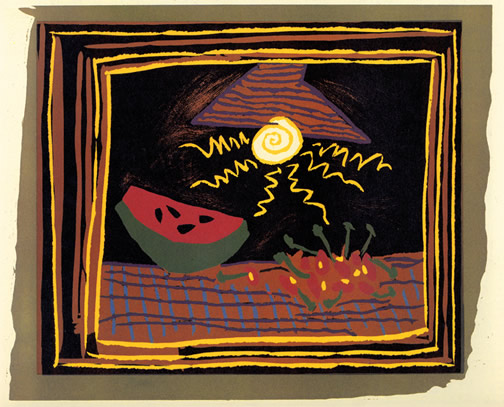 This
seven-color linocut, Nature
morte à la pastèque, 1962
This
seven-color linocut, Nature
morte à la pastèque, 1962
(Still life with watermelon and cherries) was created in
1962.
It is numbered 137 from the limited edition of 160 and signed by
Picasso.
One of the linocuts of this image from the edition of 160 was featured
in 1985 at the Metropolitan Museum of Art which had an exhibition
solely of Picasso's linocuts.
Picasso worked intensely on linocuts in the years from
1954 to 1964. He met the printer Arnéra in Vallauris, with whom
he began fruitful conversations that resulted in the making and
printing of 200 linocuts, this one among them.
This is the first of six still life linocuts created by Picasso in 1962
and one of the most colorful.
Most of Picasso's linocuts from 1962 were inspired by Jacqueline who he
married one year earlier (and had met in 1953).
The first linoleum
block prints (or linocuts) were carved by
Picasso in 1939. The linocuts are a relief method of
carving and printing similar to a woodcut but using linoleum instead of
a wood surface. By 1951, when Picasso was 70 years old, he
renewed his interest in the art of linocuts and continued working on
them for another 20 years.
In this year, 1962, the Museum of Modern Art in New York had a "Picasso
80th Birthday Exhibition".
 This
seven-color linocut,
This
seven-color linocut,  This
seven-color linocut, Nature
morte à la pastèque, 1962
This
seven-color linocut, Nature
morte à la pastèque, 1962